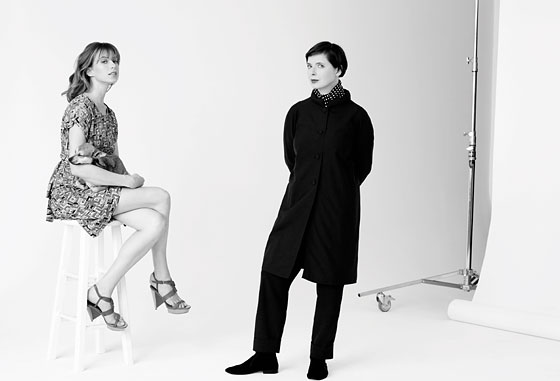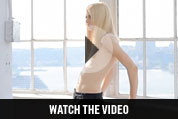
Elettra Wiedemann would rather not talk about her mother. Not because she doesn’t love her a whole lot. She even likes her, which is something not all 28-year-olds can say. “It’s just that when you’re all but 30 and it’s still about your mom, it gets a little … repetitive,” she explains delicately. “I am a fan of my mother’s, but I’m not like a fan of my mother’s,” she says. “This whole style-icon title that she has is very kind. But I know my mother at her core. So I don’t associate the iconic Isabella Rossellini with my mom Isabella Rossellini.”
Like her mother, Wiedemann works as a model. But she also recently got her master’s degree in biomedicine at the London School of Economics with a dissertation on feeding post–climate change populations through vertical farming—all the while booking editorial jobs and playing the part of spokesmodel for Lancôme (the brand to which Rossellini famously lent her face for years). “Models are like athletes: You burn hard and fast,” Wiedemann says. “Going to the LSE was setting the groundwork for a plan B if and when a day ever comes when the phone stops ringing with modeling jobs. You can’t count on a career like my mom’s. That’s very rare.” (If she hadn’t gotten into modeling, Wiedemann says she’d likely be working on Capitol Hill and “being much more serious.”)
Back in New York after the two-year program, the Manhattan-raised Wiedemann lives in the West Village with her fiancé, business consultant James Marshall, and “son,” a Chihuahua–rat terrier mix named Happy. She and Rossellini—who is now in Bellport—get together every couple of weeks, but they’re not one of those mother-daughter duos who can’t choose toothpaste without dialing up the other for a consult. And Wiedemann has never been one to shop Mom’s closet. “Even when it’s just us at home, she’s always very elegant. When I’m at home, I’m not dressed in a gorgeous Armani vintage men’s suit. I’m in, like, an old silk slip from the forties and ripped Seven jeans,” says Wiedemann. “We also have very different body types. So structurally that wouldn’t really work.”
Among the young designers who count her as a muse are Chris Benz and Prabal Gurung, the latter of whom revamped a gown of her grandmother Ingrid Bergman’s for Wiedemann to wear at this year’s Met ball. But when she’s not gussied up for an event, you’ll find her in mostly vintage pieces. Or you would have until just recently. At the end of a two-week vacation of Blue Lagooning, glacier hiking, and lava-field frolicking in Iceland with her father and stepmother and their kids, all of her luggage was stolen. Shoes, dresses, underwear, jeans, belts, long-lens camera, and “this new, really gorgeous yellow vintage dress from Reykjavik”: all gone. “I had, like, ten minutes where I was absolutely furious, and then I was like, You know what? Whoever stole it must’ve needed it more than I do.”
Isabella Rossellini misses modeling. Sometimes terribly. Occasionally, when she looks at Vogue, it hurts. These days, she’s very busy with directing and acting and animal-behavior courses at NYU (she’s developing a short-film series about animals’ maternal instincts, a follow-up to her sex-life-of-insects-and-other-creatures series, Green Porno) and, when she can squeeze it in, Zumba classes. It’s just that modeling was her first love. “I loved the people in fashion, the photographers, the photographic studios. It’s Barbies for the grown-ups.”
For most of her life, Rossellini didn’t pay much attention to age. She began modeling not as a teenager but at 28. “Nobody asked me how old I was,” she says. “By the time I was successful with covers of Vogue and Harper’s Bazaar and Vanity Fair and the Lancôme contract, someone asked how old I was. They almost fainted when I said 33.” Now that she’s almost 60, the subject is unavoidable. “There are consequences with age, so you have to evolve. I’ve loved becoming a filmmaker. But I would love to continue modeling, and there isn’t really any job for me. It’s being marginalized—that’s the sad part.”
She finds the aging process frustrating, and not only professionally. “I don’t look at Vogue to ask what I’m going to wear. Because it’s something on a body too young. I have to look at the social pages to see women my age. To see how Amanda Burden is dressed and say, ‘Hmmm. Maybe I should try that.’ ” She continues, “They give advice to the young people: ‘If you are brunette, this color would be best.’ But I would love it if the magazine said, ‘When you are in your sixties and your neck is like this, consider wearing this.’ ”

Rossellini cites Jackie Onassis and Georgia O’Keeffe as mature women whose styles she has looked up to. But contemplating which of her peers’ styles she finds inspiring, Rossellini gets a bit stumped. Catherine Deneuve is one. And then there’s Meryl Streep. (“I can’t think of a definite style [for her], but I’m so glad she’s successful and working and intelligent.”)
Her own unmistakable, minimalist look materialized in her early modeling days. “A great bag and jewelry and red lipstick and you’re ready. I remember my mother still doing a lot of that ‘What am I wearing?’ I’m more certain.” Her mother was Ingrid Bergman, of course, making Rossellini no stranger to what it’s like to be the daughter of an icon.
Wiedemann’s pursuit of a master’s in biomedicine was a bit of a surprise to Rossellini, but not the modeling. She attended her first Vogue cover shoot at 3 weeks old, Rossellini breast-feeding between shots. And Rossellini never had reservations about Wiedemann joining the family business. “Being my daughter, Elettra understood how it worked. You know how to avoid the pitfalls. Of course, if you are a girl from the countryside of Russia sent to New York by yourself and you have a million managers who get a percentage, it can be ‘Oh my God, my poor daughter!’ But we know exactly who is the best lawyer, who is the best agency. It’s a little harder to be taken advantage of if you’re one of us.”
